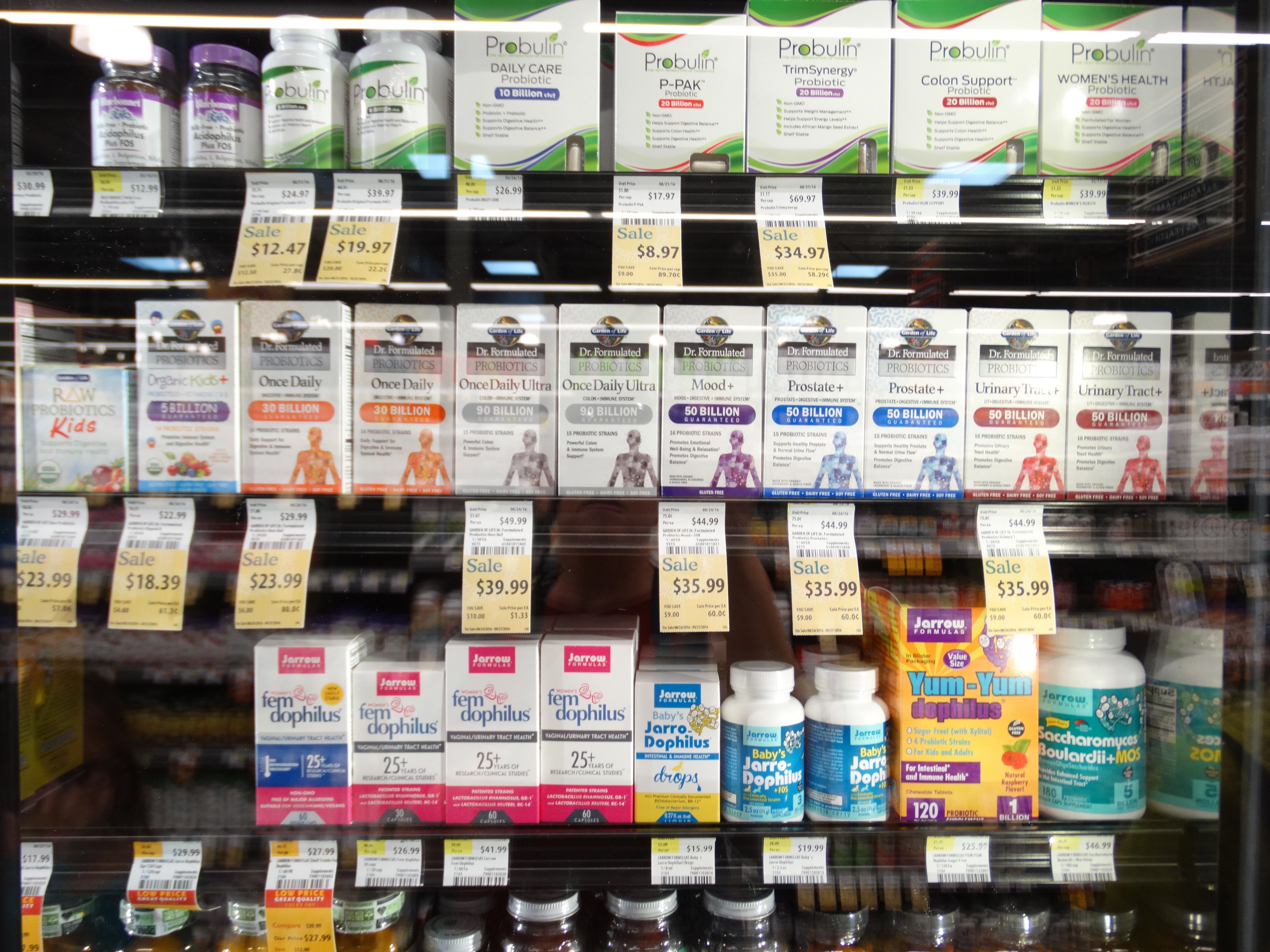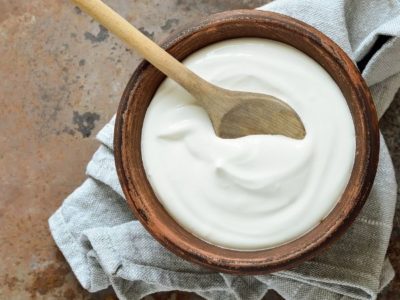Last Updated on June 29, 2022 by Rebecca Huff
The food industry uses the word “probiotics” liberally in marketing.
I get a little miffed at the food industry when someone tells me they’re eating yogurt for the “good bacteria” it provides while holding a brightly colored cup of deception. Mostly because I know that people are being misled by less than truthful marketing and that bugs me. Often, what I find people eating “for health” is stuff like Activa which has about 8 teaspoons of sugar per 6 ounce container or Yoplait which has not only high fructose corn syrup and sugar but also artificial colorings and flavorings. Most are highly sugared and colored varieties like Trix or Gogurt “the junk in a tube” which are just a chemical concoction.
Can I help save you some wasted money, a few pounds and possibly improve your health over the long run? Listen, if you're “doing this for your health” you don’t need colorful yogurt, you need probiotics. Leave the Dannon fruit on the bottom right there on the shelf and head over to the supplement section instead. If you just really want to eat yogurt, I’ll provide some healthy suggestions at the end of this post.
What’s in yogurt that is beneficial?
Probiotics are live bacteria and yeast that are often referred to as “good bacteria” because they help promote a healthy digestive tract and immune system. There are literally dozens of different probiotics, some are categorized as Lactobacillus and others as Bifidobacterium. Each category has different strains.
Probiotics are measured in colony forming units (CFUs) and there are many different “strains” of bacteria, with the most popular being L. Acidophilus and B. bifidum which help keep the microflora of the small intestines balanced. This is especially useful to offset the effects of antibiotics.
Another popular strain of probiotic is L. fermentum which is found in some of my favorite foods: fermented foods like kimchi, sauerkraut and sourdough. This lactobacillus strain also helps promote a healthy level of gut bacteria.
Probiotics are essential for maximum digestion of food and absorption of nutrients. Probiotics also aid in the elimination of toxins. For example the strain L. rhamnosus is perfect for carrying when traveling as it can help prevent traveler’s diarrhea. A good combo to carry when traveling is charcoal and probiotics.
When I am traveling and get a bout of stomach woes, I alternate the two every hour until I feel better. It’s a lot easier to carry than Apple Cider Vinegar, which is my number one treatment for food related stomach problems. I carried probiotics and charcoal all across China with me and believe me, I was so glad I did.
It’s important to choose your probiotic supplement based on your health issues, as there are many strains which have varying benefits so it is likely that a probiotic supplement that I take for my health concern may not have much of an impact on your health problems. If you’re not certain which strain to take, look for a broad spectrum probiotic, also sometimes labeled as multi-probiotics. Look for products that contain 50 CFUs or higher.

Tips when selecting a probiotic
- Make sure the product is being stored according to the product label (some have to be refrigerated)
- Check for any genetically engineered ingredients and avoid them
- Research and choose a brand that is trustworthy, or ask a professional
- Check the potency, remember 50 billion CFUS or higher
- Look for the words “potency guaranteed until time of expiration” to make sure that the CFUs aren't only counted at the time of manufacture, meaning it's shelf-stable
- Choose a product with multiple strains, diversity is good
- Look for the most important strains I mentioned above: L. Acidophilus and B. bifidum, the more diverse the strains the more likely the bacteria will work all the way through your digestive system.
Probiotic rich foods besides yogurt
In addition to supplementing with probiotics you can also try to add probiotic foods to your diet. These foods include:
- Pickled or sour vegetables such as pickles, sauerkraut and kimchi
- Miso soup
- Kefir
- Yogurt (preferably cultured from raw milk but definitely not highly sugared and colored varieties like Trix or the junk in a tube)
- Sourdough bread
- Kombucha
- Raw cheese (especially soft cheeses)
- Spirulina, chlorella and blue-green algae (green powders you can add to your smoothies and juices)

Depression and even some learning disorders has been linked to low levels of good bacteria in the gut. I recently found a probiotic blend specifically formulated to improve mood. The bottle claims that it contains the probiotics L.helveticus and B. longum in the amounts clinically shown to support mood and relaxation. In some studies researchers have linked a reduction in anxiety to balancing the composition of gut flora.
Weight loss efforts receive a helping hand from a good probiotic because they help to break down fibers that the body can't digest. Gut bacteria in normal weight people has been shown to be different than gut bacteria in overweight and obese individuals.
Candida, which is a yeast overgrowth inside the body, has been treated successfully using probiotics and a healthy diet plan such as the menu plans I create for following the Trim Healthy Mama plan or those I have created to quit sugar. I successfully treated my own Candida almost a decade ago using VSL3 and following a sugar free diet.
Another important benefit from probiotics is a mother’s gut health. Gut health can be passed on to an unborn baby. That means it is important to work on building up the good bacteria in your body when you first start contemplating trying to conceive. The easiest way to get good bacteria in your diet is to simply add fermented vegetables and/or a truly healthy yogurt on a daily basis. However, the most reliable method is taking a good supplement.
Kids with a strong immune system typically have a very well balanced gut flora. In addition to improving a child’s immune system, probiotics can help children maintain a healthy weight. Maintaining a healthy gut can also support urinary tract health in children. If a child needs to take antibiotics it is especially important to replace the good bacteria, just make sure when supplementing with probiotics that they are taken a few hours apart from the antibiotics.
The link between the gut and brain is being studied concerning autism. Some research indicates that there could be a connection between early antibiotics use and the development of autism. These studies further indicate that the use of probiotics may aid in the treatment of symptoms of autism “by promoting the growth of beneficial bacteria and inhibiting the growth of harmful bacteria. Researchers have identified an overgrowth of certain strains of Clostridia [a gut bacteria that prevents food allergies] that produce propionic acid, a neurotoxin that crosses the blood-brain barrier and may disrupt normal brain development in early childhood, in the guts of autistic children.” (1)
Surprising new discovery about good bacteria
It turns out that good bacteria is stored up in the appendix of all places! That’s right, the latest research now shows that apparently this previously thought useless organ is a storehouse for storing up good bacteria to be released just when your body needs it.
Eating yogurt for the probiotics
As for eating yogurt for the probiotics, only varieties that have the words “contains active live cultures” on the label have true benefits. If the yogurt is heated for pasteurization the bacteria have likely been killed. Organic yogurts are not commonly heated after fermentation, keeping the live cultures intact. It’s hard to be sure how many CFUs are in a container of yogurt by the time you consume it.
Like I always recommend, Read The Ingredient Label, not just the front of the package. If the ingredient list is super long, just put it back on the shelf. The shorter the list, the better the product. Some brands that I prefer are the plain versions by Fage, Siggi’s, Nancy’s, Brown Cow, Stonyfield and my favorite is to find local yogurt cultured from raw milk!
I prefer to buy plain unsweetened yogurt and add what we like to it. My children enjoy whole milk greek yogurt, especially the ones with cream on top. They often drizzle a teaspoon of honey or maple syrup or all fruit jam on top. Sometimes they top it with homemade granola. I have made it into popsicles with fruit.

For myself, because I don’t have the metabolism (or energy) of a kid, I like to add Gentle Sweet and berries to plain unsweetened yogurt. Yogurt can be great for weight loss as long as you choose the right variety.
I hope to make my own yogurt in my instant pot in the near future after having tried it while traveling in DC. So, if you have any tips on doing so, please leave them in the comment section below.
Has taking probiotics helped you overcome a health challenge? If so please tell me all about it!
Disclaimer. This information contains personal experience only and is not intended to replace your own doctor's recommendation. Please check with your doctor before using supplements. This information has not been evaluated or approved by the FDA and is not necessarily based on scientific evidence from any source. These statements have not been evaluated by the Food and Drug Administration (FDA). These products are intended to support general well-being and are not intended to treat, diagnose, mitigate, prevent, or cure any condition or disease. If conditions persist, please seek advice from your medical doctor.
Source:
Abdellatif, Basma et al. “The Promising Role of Probiotics in Managing the Altered Gut in Autism Spectrum Disorders.” International journal of molecular sciences vol. 21,11 4159. 10 Jun. 2020, doi:10.3390/ijms21114159


 Energizing Breakfast Tacos Recipes
Energizing Breakfast Tacos Recipes
Leave a Reply
You must be logged in to post a comment.